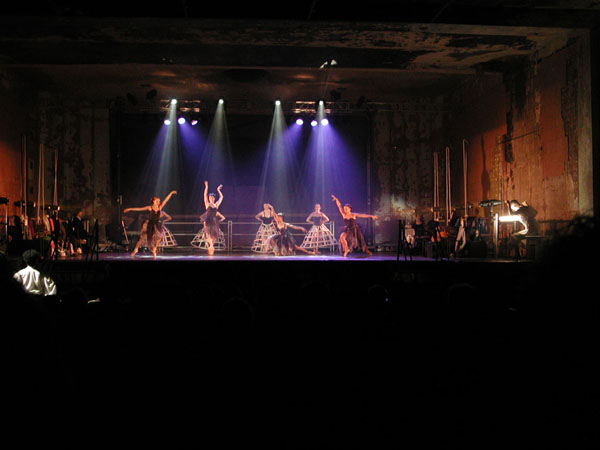The Disappearing Dance Curator
Both Cowles and the Southern have forsaken curated performance seasons for rentals and bottom line-friendly shows; Walker's dance-focused curator was recently laid off. Lightsey Darst asks, "Are dance curators a luxury we can't afford? Does it matter?"


THE TWIN CITIES CAN’T AFFORD DANCE CURATORS: that seems to be one of the messages of the last five years. Consider the evidence:
- The Southern Theater’s 2011 collapse came after the theater was unable to repay $350,000 in McKnight fellowship funds poached for general expenses. The underlying problem that generated this malfeasance is that the Southern couldn’t pay its bills—in other words, that its curatorial model didn’t work. A mix of small companies and independent choreographers, overseen by Jeff Bartlett, then Dylan Skybrook, then Laurie Van Wieren, the Southern’s season was lovely and beloved, but it didn’t bring in the needed revenue. (I would be remiss if I didn’t add that the Southern is still alive, run as a rental house by the indefatigable Damon Runnals.)
- The flagship Cowles Center for Performing Arts has no curator. Frank Sonntag, who was executive director when the Cowles opened, did not curate the first season, and he got flak for yelling at people (he yelled at me). But he did attend local dance events, he was trying to make sense of the scene here, and at least yelling is a method of communicating, however flawed. The current Cowles management (Lynn A. Von Eschen is the executive director, Randy Ingram the general manager) seems to make no such efforts; the bottom line is what matters.
- The mighty Walker just laid off Michèle Steinwald, their dance-focused performing arts curator. The Walker will still have dance curation: Steinwald will finish several projects for the institution and may work on contract in the future, and anyway Philip Bither can pick up the dance duties, as he did before Steinwald arrived. But Steinwald’s dance background set her apart—and it’s a background the Walker has decided it can do without.
I know, apples to oranges. Cowles’ math might prohibit curation, the Southern isn’t much like the Walker, etc. Still, it’s hard not to feel that the verdict is in: dance curation is a luxury we can’t pay for.
What does it matter? Artists I spoke with weren’t unanimously saddened by the loss: “Minneapolis can’t afford paid curators until it can afford paid dancers,” one said. The sentiment is understandable. Curators interrupt cash flow, piddling as it is; they also say no to work they don’t like, which creates resentment.
_____________________________________________________
Curators are the editors of the dance world. Without them, the stage goes to those who can pay for it. Some favor this democracy of cash; I don’t.
_____________________________________________________
But that no is the flipside of a meaningful yes, and that curatorial yes, a sense of selection by someone who knows what good dance looks like, creates excitement for audiences. I still feel like I’m opening a present when I see the Walker season release—which is how I used to feel about the Southern release, and how I felt last year about Northrop’s season, curated by the ambitious Ben Johnson (who’s left us for LA, alas). Ideally, a curated season frames work and educates its audience, in the process shaping new opportunities for choreographers and companies who are ready for them. Curators are the editors of the dance world. Without them, the stage goes to those who can pay for it. Some favor this democracy of cash; I don’t.
But, even granted the importance of curation, do we need professional curators? The curatorial urge seems to arise without pay (or without much pay): people get a space and they put their friends and their friends’ friends in it. Recent examples include Jaime Carrera’s Outlet series (in the basement of a bodega) and Nastalie Bogira’s ongoing Pleasure Rebel (at the Bryant-Lake Bowl). These events are well-attended, fun, intermittently brilliant. What more could you ask for?
Well, you could ask for the further development of the curatorial art. You could ask that these curators get a little capital so they can push their selections forward. Or you could say something about the public, as in the general public, which doesn’t get into the niche performances cited above. But that sounds hopelessly naïve: is there such a thing as a general public, and wouldn’t the avant-garde face away from it if it did exist? “The public” might be a tyranny, might be the very tyranny of cash democracy that curators work against. And yet I think we lose something if we have no dance curators at large, permanent, easily accessible spaces. We lose a sense of connection, a say in a broader conversation.
Enter the good news of the week, or perhaps the year: the Ritz has just hired Laurie Van Wieren as their new curator/director of programming. The Ritz, renovated and opened by the Ballet of the Dolls in 2006, is still paying off its building loan, but the theater itself is operating in the black (!), and Ritz/Dolls director Myron Johnson “feels like it’s time to develop the theater;” Van Wieren says, it’s time to move beyond the current mix of Dolls performances and rentals and “get the community in here.” How will this work financially? Van Wieren wants to get in five or six companies (besides the Dolls) who can fill the mainstage theater, then curate split bills, a Studio Series in the Dolls’ back studio (which can seat a hundred), and other programs down the road. “This is the dream,” she says—a dream contingent on funding, the sort of funding the Ritz hasn’t gotten yet and can’t get without some ambitious programming. Given what happened at the Southern, it’s a gamble, or as Van Wieren puts it, “an experiment.” Openness is crucial: “The only thing that’s going to work is if everybody knows what’s going on,” Van Wieren says. But despite the risk, “the possibilities are exciting, and Myron is so positive about getting people in here—I just have to go with it.”
A new dance center for the Twin Cities, at the Ritz, helmed by Van Wieren: it’s a thrilling idea. Van Wieren knows what she’s doing artistically and knows how to connect, and she’s done her homework on the presenter’s balance sheet. Nearly 30 years old, the Dolls are one of the steadiest and most beloved dance companies in the area, yet they’re often peripheral to dance conversations here—maybe because they don’t seem to need much from anyone else. Putting their showbiz acumen and plucky self-reliance closer to the center might be good for everyone.
______________________________________________________
About the author: Originally from Tallahassee, Lightsey Darst is a poet, dance writer, and adjunct instructor at various Twin Cities colleges. Her manuscript Find the Girl was recently published by Coffee House; she has also been awarded a 2007 NEA Fellowship. She writes a weekly column on dance for mnartists.org.